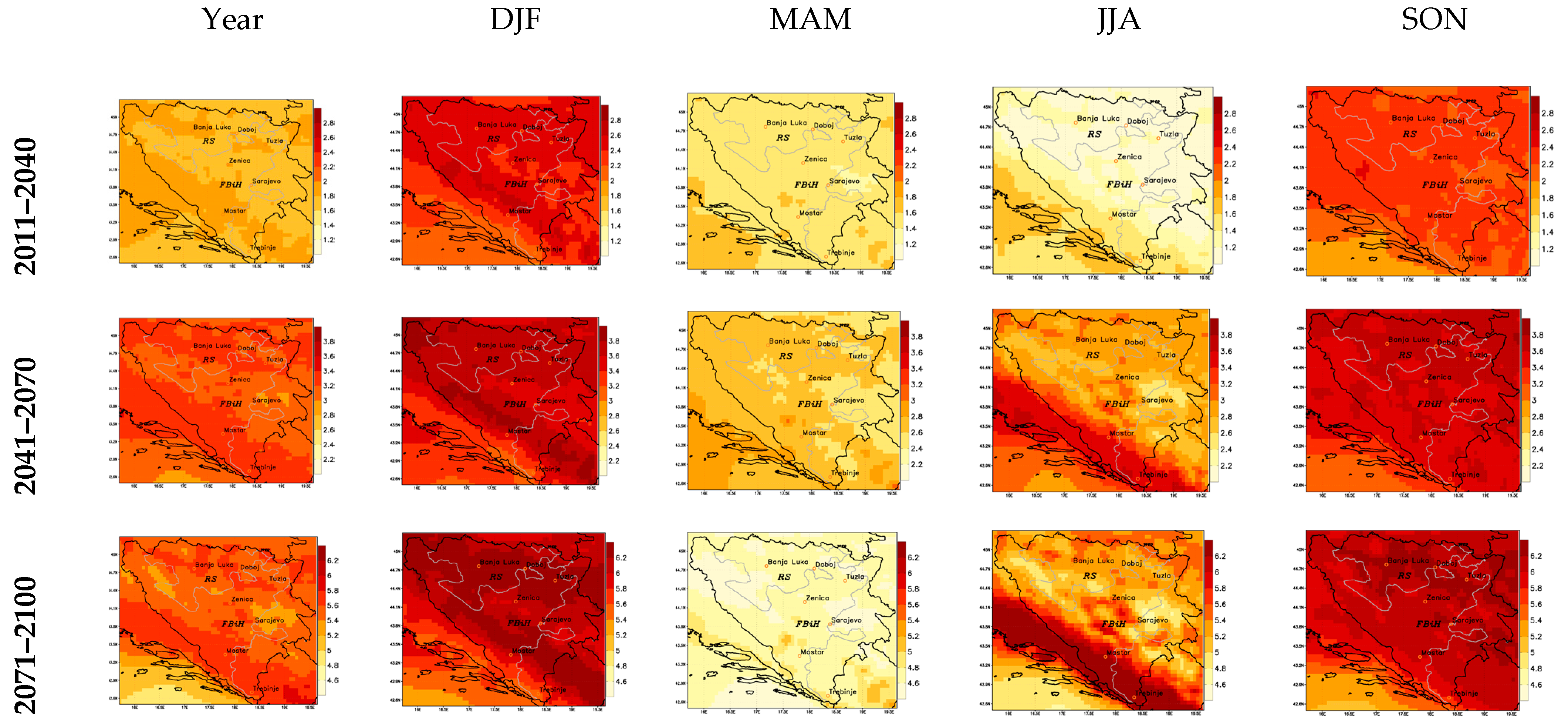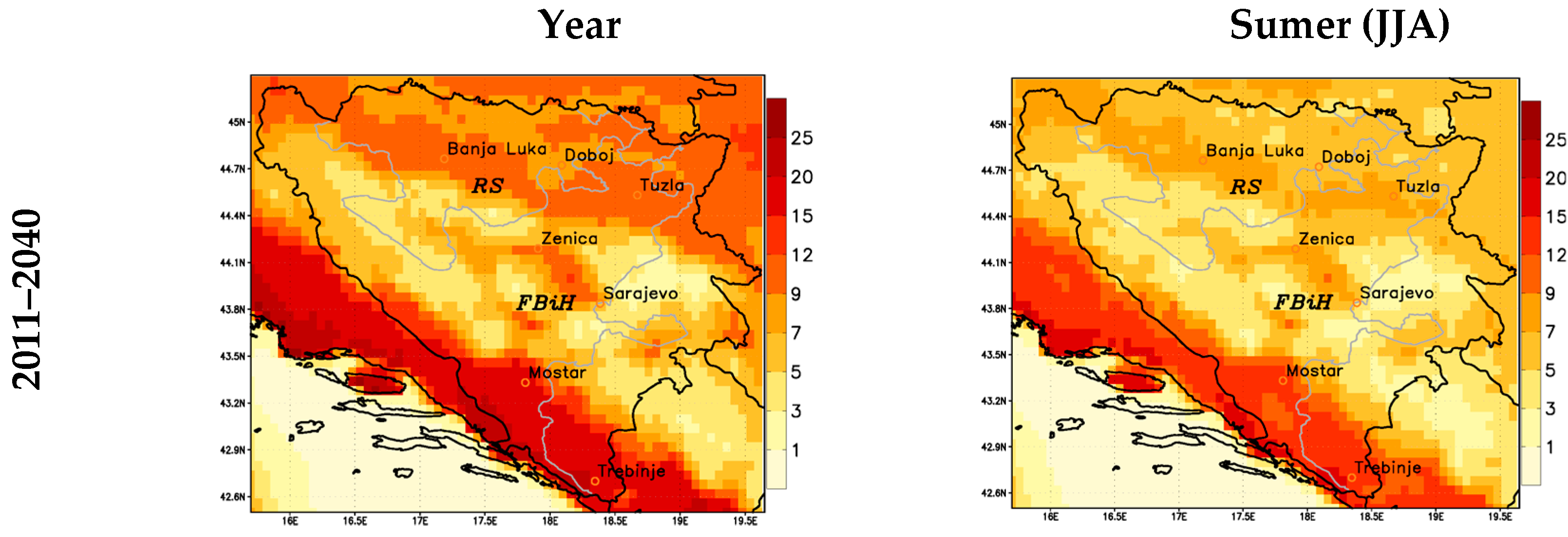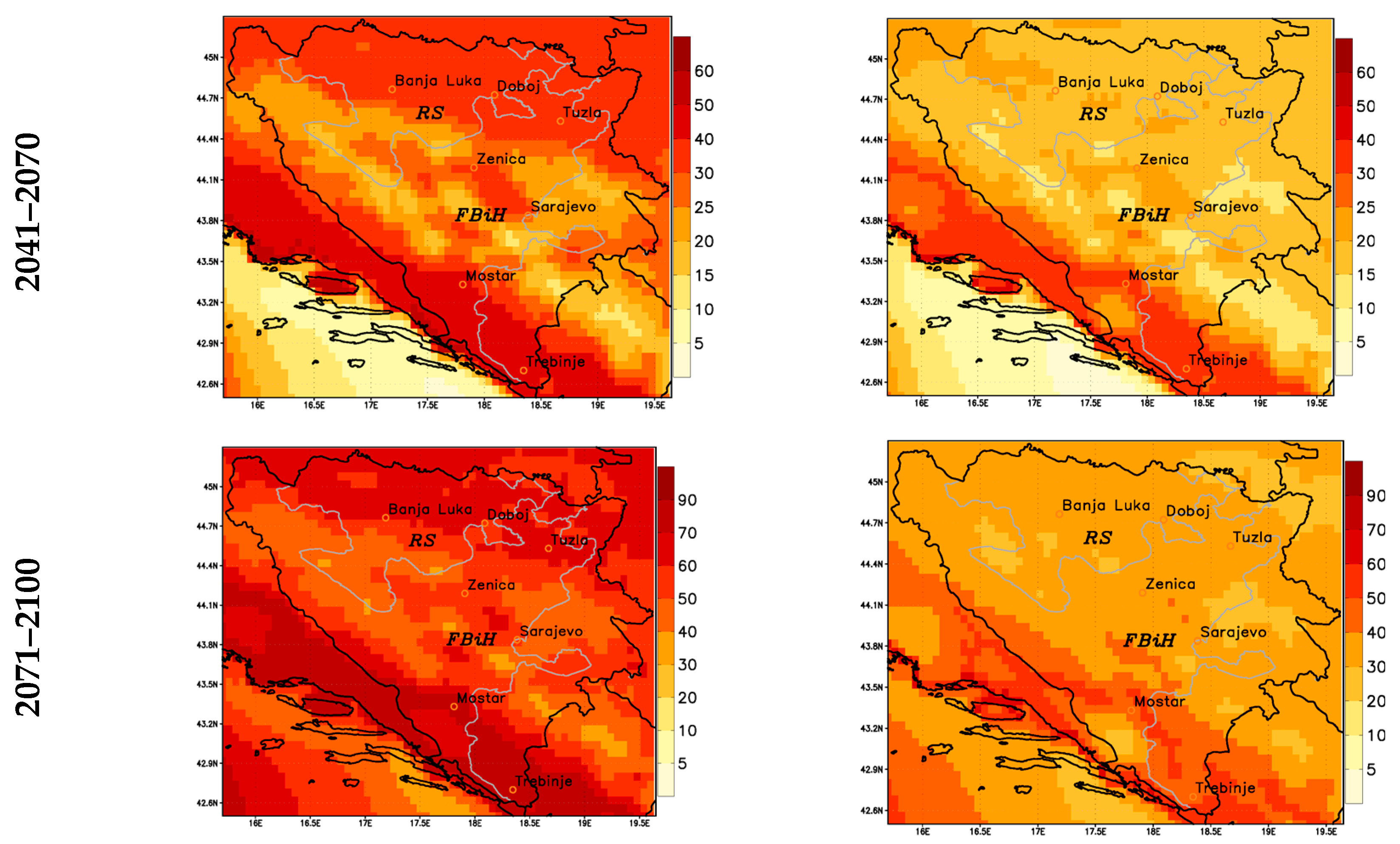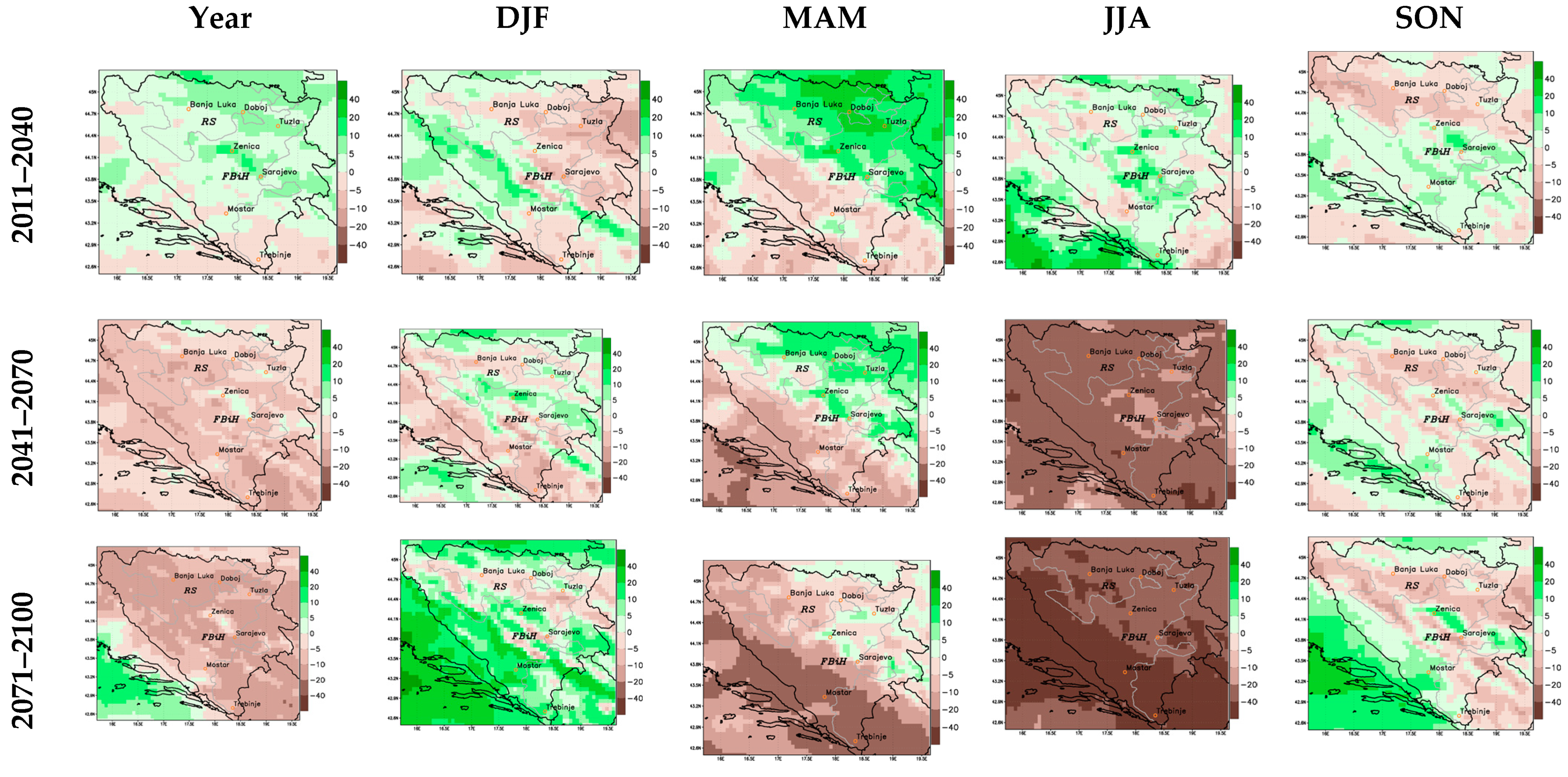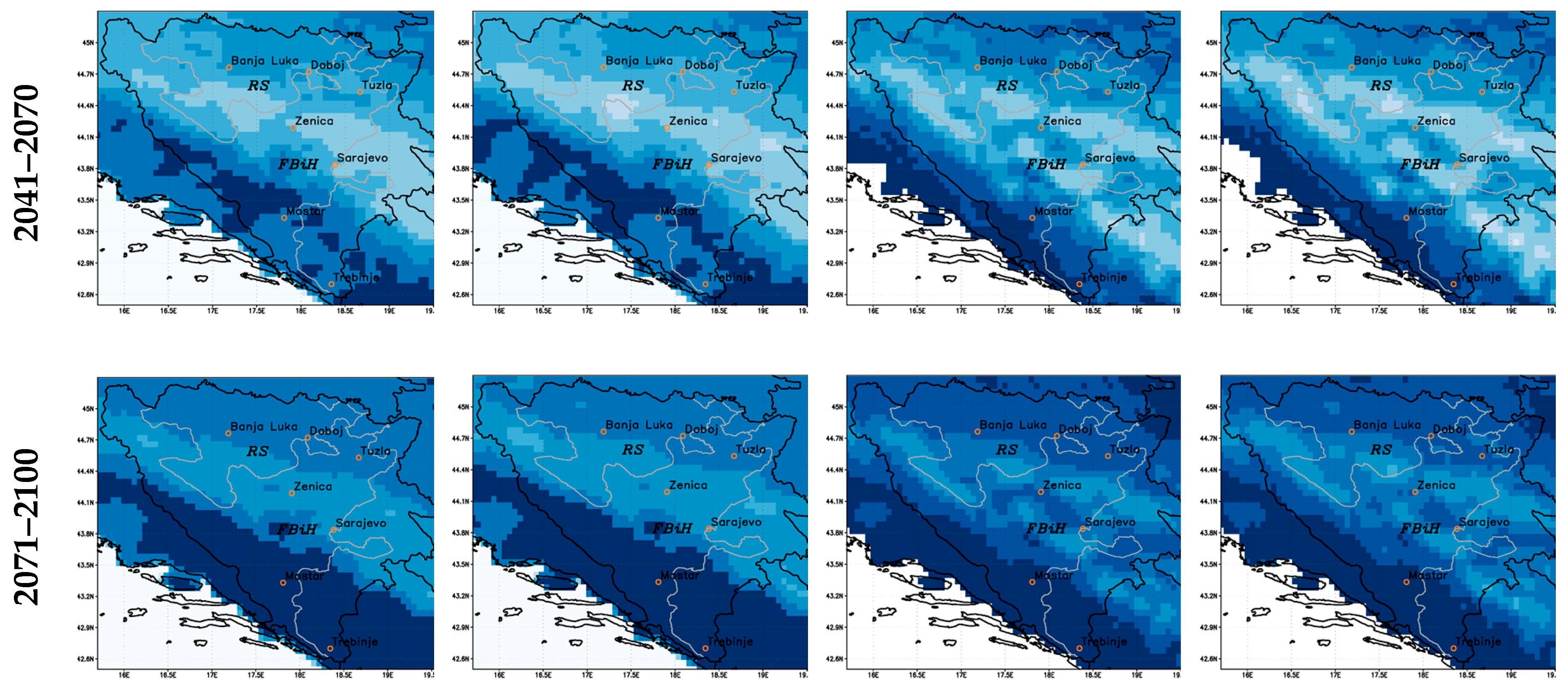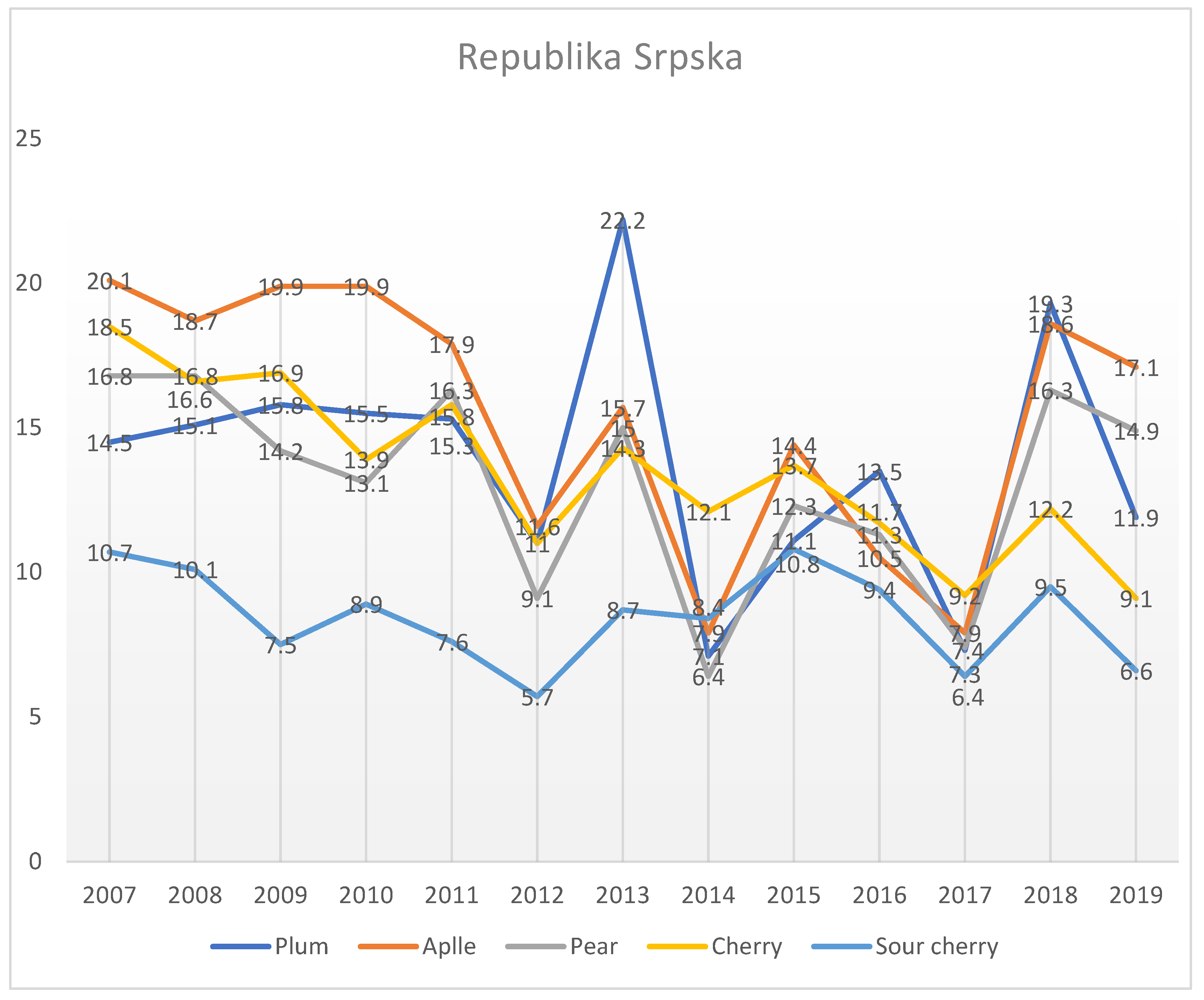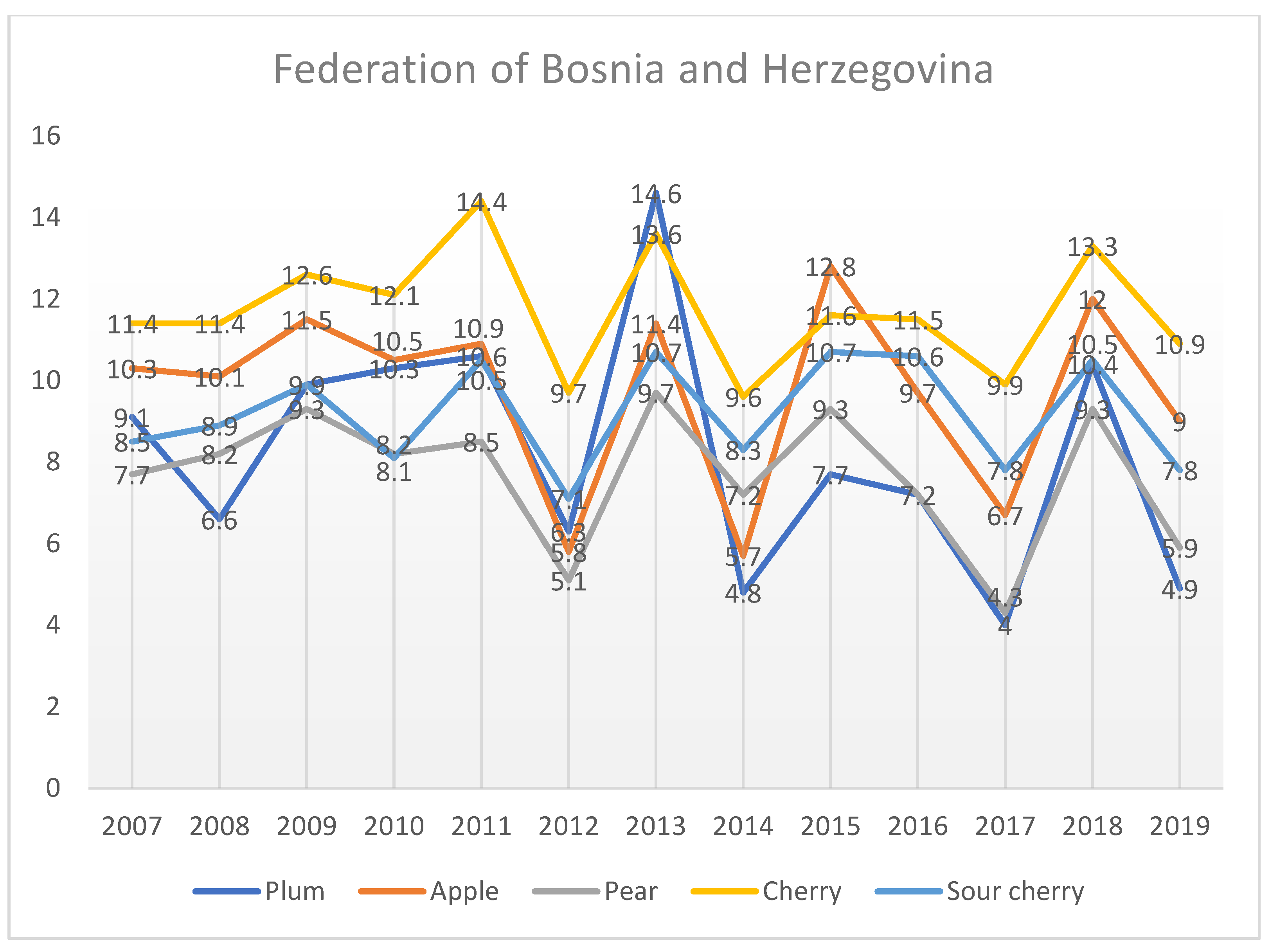1. Introduction
The changing climate, and particularly changes in climate extremes are one of the crucial challenges posed on human society and the environment [
1]. It is increasingly accepted that climate change affects the frequency and intensity of extreme events. Climate change is having an increasing impact on the agricultural sector in Bosnia and Herzegovina. These impacts are particularly pronounced in the XXI century, and are reflected in increasing air temperature and long-term heat waves, which, with a lack of precipitation, cause droughts, increasing the number of days with hail clouds and hail, reducing rainfall during the summer and reducing the number of days with snow and snow cover retention [
2]. Drought is a complex phenomenon that occurs due to a long period of absent precipitation above a geographical area. It is triggered by the abuse of normal atmosphere circulation. Unlike aridity, which indicates a permanent lack of normal precipitation within a region, drought is a short-term lack of precipitation followed by an increase in air temperature. As we speak of the drought phenomenon, we usually refer to agro-meteorological drought, i.e., the impacts and consequences that affect agricultural crops [
3]. The increasing variability of weather conditions were recorded in all seasons, with rapid changes that occur over short periods of time of extremely cold and hot weather, or from a period of extremely high rainfall in dry periods [
4,
5]. During the period 2000–2021, almost all years had the characteristics of extreme weather conditions: floods in 2000, 2001, 2009, 2010, 2014, 2018, 2019, 2020, and 2021, drought and heat waves in 2003, 2007, 2011, 2012, 2013, 2015, 2016 and 2017, a wave of cold in early 2012, stormy winds in 2012, 2017, 2019, 2020, and 2021, and an extremely large number of days with the appearance of the city in 2018. During the last five years (2017–2021), there were intense late spring frosts, which caused great damage to fruit growing. Climate models suggest that these extremes will intensify in the future and will pose a greater risk and threat to fruit growing in Bosnia and Herzegovina. Climatic extremes in the form of strong and stormy winds (impact on fruit growing and farming) also have a negative impact. Based on previous research, increasing climate variability in Bosnia and Herzegovina has been observed [
6,
7,
8,
9]. All changes in temperature extremes that were observed globally showed trends consistent with an increasing tendency of climate system warming. Global-scale studies showed that the strongest changes were displayed by the minimum temperatures (temperature of the coldest night increased almost 4 °C globally since the middle of the 20th century). Similar was found for Europe at the continental scale [
10,
11]. Nevertheless, in Bosnia and Herzegovina and other parts of Southeastern Europe, changes in maximum temperatures were much stronger than changes in minimum ones, although they also displayed the upward trends. This has led to an increasing frequency of droughts. Since the effects of drought often accumulate slowly over a considerable period of time and may linger for years after the termination of the event, the onset and end of drought are difficult to determine [
12].
There is an obvious lack of scientific research and published papers on the impact of climate change on fruit production in Bosnia and Herzegovina. This problem was pointed out through several national communications on climate change in B&H. However, national communications took over data from scientific papers, which were quite scarce. There are almost no scientific papers in Bosnia and Herzegovina related to climate projections and their possible impact on fruit production. There are several papers that deal with climate change and agriculture and one paper that deals with the possible impact of climate change on grape production in Bosnia and Herzegovina [
13,
14,
15]. The basic idea and purpose of this paper is to fill the existing gap. This is especially important because the results of research can be an integral part of strategic and planning documents that address the agricultural sector, and especially the production aspect in terms of expected climate change.
According to the data of the Agency for Statistics of Bosnia and Herzegovina from 2020, in the structure of the total agricultural land, orchards participate with 4.5% (25,810 ha) and vineyards with 0.5% (2910 ha). The most common fruit species are plum, apple, pear, cherry and sour cherry, and strawberry and raspberry [
16]. The main climatic pressures on fruit production are the appearance of late spring frosts, droughts, heat waves, intense precipitation and the appearance of hail.
According to the strategic plan of rural development of Bosnia and Herzegovina for the period 2018/2021, adopted by the Ministry of Foreign Trade and Economic Relations of Bosnia and Herzegovina, fruit production in B&H takes place in areas that according to available data amount to about 101 thousand ha, planted with about 24 million native trees. The average annual fruit production is about 264 thousand tons. The level of production, fruit yields and production stability are greatly influenced by weather conditions that have changed significantly in recent years, especially the increasing occurrence of late spring frosts and longer dry periods. Plums (53.4%), apples (24%) and pears (10%) are the most represented in fruit production, although a large number of other fruit species are also grown. The production of berries in Bosnia and Herzegovina has experienced a strong expansion in recent years, especially the production of raspberries and strawberries. The average production area under strawberries and raspberries is about 3 thousand hectares, from which, on average, about 10,000 tons of strawberries and about 20,000 tons of raspberries are produced. The total area under vineyards, according to estimates, occupies about 3660 hectares on which 15.3 million native vines are planted, from which an average production of about 2 kg of grapes per native vine is achieved [
17].
According to the Laws on Statistics in Bosnia and Herzegovina, the competent institutions dealing with data collection in the field of agriculture are the Agency for Statistics of Bosnia and Herzegovina (state level), the Republic Institute of Statistics Republika of Srpska (entity level Republika Srpska) and the Federal Statistical Office (entity level Federation of Bosnia and Herzegovina). More detailed data on agricultural production are available in the entity institutes from the Republika Srpska and the B&H Federation. At the level of Bosnia and Herzegovina, the Agency collects and publishes only general data on agricultural production.
Republika Srpska: In the structure of large fruit orchards during the last ten years (2010–2019) (measured by the number of trees), the relative share of plums is decreasing, and the share of apples and pears is increasing, which is the result of production orientation when raising new orchards. All other fruit species together participate with 5% in the total number of fruit trees. Plums are produced, on average, at 82 thousand tons per year, apples, 41 thousand tons, and pears 14 thousand tons. Fruit grown in Republika Srpska are characterized by dual production; on the one hand, there are family farms that have old plantations of heterogeneous assortment, which use traditional technology and most often process fruits into brandy, and on the other hand there are entrepreneurs who have younger plantations of uniform assortment, but are often unmatched to market demand, use modern production technologies, and produce fruit exclusively for the market [
18].
Federation of Bosnia and Herzegovina: In the territory of the Federation of B&H, a large number of fruit species of temperate climate are grown, i.e., apple, stone and berry fruits. The development of fruit growing in the Federation of B&H, based on intensive and modern fruit production, and not on the revitalization of pre-war orchards, proved to be successful. The most important fruit species is the plum with 5.4 million fruit trees, followed by the apple with 2.5 million fruit trees and the pear with 1.2 million trees. In the total production of plums, it contributes, on average, with 48 thousand tons, apples with 25 thousand tons, and pears with 9 thousand tons of fruit. Average yields per fruit tree vary from year to year, primarily as a result of the climatic conditions in which production takes place (data source:
http://fzs.ba/, accessed on 15 October 2021).
Brcko District of Bosnia and Herzegovina: in the Brcko District of B&H the most common fruit species is plum (about 400 thousand trees), followed by apple (80 thousand trees) and pear (50 thousand trees), with annual variations in yield and production as well as in other districts of B&H [
17].
2. Study Area
The study area for research is Bosnia and Herzegovina (B&H), a country located in the southeastern part of Europe, between latitudes 42°33′00″ and 45°16′30″ N and longitudes 15°44′00″ and 19°37′41″ E. The territory of the country covers three main physical macro regions: peri-Pannonian region (rim of the Pannonia basin in north), Mountain and Basin region (Dinaric Mountains chain in central part of the country) and sub-Mediterranean region (Herzegovina region in south). Given the stated terrain configuration, it covers a wide range of altitudes—from 0 m a.s.l. in Neum (located at the Adriatic Sea cost) to 2386 m a.s.l. at the Maglić Mountain. The thermal regime and climatic characteristics of Bosnia and Herzegovina are influenced by two action centers of the atmosphere: the Azores anticyclone, which causes stable weather, and in summer, warm weather, and the Icelandic cyclone, which brings precipitation. In winter, the influence of the Siberian anticyclone is occasionally registered, which is followed by cold and mostly dry weather, while in summer there is also the influence of the anticyclone, which has Saharan and, thus, Mediterranean origin, which causes extremely warm and dry weather. In the northern and western part of (B&H), in areas up to 500 m height above sea level mean annual air temperatures ranged from 10 to 11 °C (period 1961–1990). Central mountainous part, i.e., areas over 500 m height above sea level, are characterized by average annual temperatures in the interval from 5 to 10 °C, except for the highest mountain peaks, where the temperature is below 4 °C. The warmest part is the area of low Herzegovina and the southern part of Herzegovinian Rudine, where the average annual temperatures have an average value of 11 to 14 °C, and the area of Mostar, Trebinje and Popovo polje at over 14 °C. According to Kepen’s classification, the territory of Bosnia and Herzegovina is predominantly in the C and D climate types. Most of the north has a continental precipitation regime with a maximum in the summer and a minimum in the winter months. In low Herzegovina, there is a typical maritime Mediterranean regime with a maximum in the winter and a minimum in the summer months. In the central parts, the autumn maximum dominates, while the minimum is not markedly spatially differentiated [
19]. The lowest amount of precipitation is excreted in the extreme northeast of Bosnia and Herzegovina (about 750 mm), while 21 areas of Eastern Herzegovina receive the most precipitation during the year (up to 2000 mm). Above the rest, in most of the country, 850 to 1500 mm is excreted. In the Peripannonian rim, precipitation decreases relatively regularly from west to east, while in low Herzegovina, the situation is more complex [
20]. B&H is a predominantly rural country, and it is estimated that almost two thirds of the population live in rural areas [
21].
3. Materials and Methods
Regional climate models (RCMs) are the most commonly used tools for regionalizing the results of global climate models (GCMs) and assessing changes in regional climate conditions in the future, depending on different scenarios of possible increases in gas concentrations greenhouses [
22]. The regionalization method enables obtaining relevant information on the future climate at the appropriate spatial and temporal scales necessary for the implementation of impact and vulnerability studies, especially when they are focused on regional and sub-regional domains [
23]. For the purposes of this paper, the results of regionalization of the climate scenario RCP 8.5 for the territory of Bosnia and Herzegovina were used. Scaling was performed with a non-hydrostatic regional (NMMB) model. The NMMB regional model is a non-hydrostatic model of the atmosphere that, in addition to operational use for weather forecasting in the U.S. National Meteorological Service [
24,
25], is also used in many research institutions in Europe and America [
26,
27]. The fact that the NMMB model is non-hydrostatic allows its application in integrations with extremely high horizontal expansions below 10 km (dimensions typical for convective processes). Integrations of such high horizontal decompositions enable better simulation of appropriate atmospheric non-hydrostatic processes extremely important in the development of convective systems, which are the most common cause of extreme precipitation accumulations in short time intervals, especially during the warmer part of the year [
28]. The horizontal resolution of the regional climate model is the distance between the model’s grid points (the model geographical domain is discretized in horizontal plane, with the grid points with equal distance). In this model (NMMB), the vertical resolution was 64 levels from the Earth’s surface up to 10 mb height, and the distance between vertical levels depended on height. Close to the surface is a few tenths of meters, and in the middle of the atmosphere is a few of hundreds of meters. Integrations of the NMMB model were done within the ORIENTGATE project (
http://www.orientgateproject.org, (accessed on 5 September 2021)) [
29]. The NMMB model regionalized the climate scenario RCP8.5 defined in the fifth report of the Intergovernmental Panel on Climate Change (IPCC-AR5) [
30]. The horizontal resolution of the NMMB model was 8 km. The period 1970–2000 was chosen as the reference period, while the integrations of the future climate covered the period 2011–2100. The results of the global climate model CMCC-CM were used for the boundary conditions in the integration of the RCP8.5 scenario [
31,
32].
The climate scenario RCP 8.5 made predictions for the expected changes in air temperature and precipitation for the time periods from 2011 to 2100 in relation to the base period 1971–2000. Analyses were performed for the year level and by seasons for time clips: 2011–2040, 2041–2071, 2071–2100. To analyze the change in temperature in the range of extreme temperatures, the change in the values of the climate index summer days was analyzed. This index was defined as the number of days during the observed period when the maximum daily temperature was higher than 25 °C [
33,
34]. In addition to this index, modeling was performed for the expected changes in the height of the snowstorm and the occurrence of snow days.
The most extreme scenario RCP8.5 was chosen in relation to the others (RCP2.6, RCP4.5, and RCP6.0) for the practical reason that climate change and climate extremes were very pronounced during the 21st century. Air temperatures in the largest cities (Sarajevo, Banja Luka and Mostar) have already risen above 1.2 °C, compared to the climatological norm of 1961–1990. Then, during 2011, the amount of precipitation at the annual level was 40% lower than the average (period 1961–1990), and during the summer season it was lower by as much as 60% [
35,
36]. Furthermore, the expected changes in the number of summer days and days with the appearance of snow are already happening, although the projections for the first time horizon refer to the period 2011–2040. Quality in climate extremes is becoming more pronounced and frequent, and some changes related to a significant expected water deficit, especially in the summer season (JJA); we considered it logical to make projections according to the most extreme expected scenario (RCP8.5). This decision also has a practical character because it can be useful information for policy makers and decision makers when adopting stretching documents and adopting measures for adaptation to climate change in Bosnia and Herzegovina. These climate element indices were chosen because they are crucial in terms of the effects of climate change on fruit production. They predominantly affect the duration of the vegetation period phenophases thermal regime, and the availability of water from precipitation.
5. Discussion
The obtained results indicate that the changes in the basic climatic elements, air temperature and precipitation amount will be greater in the future in relation to the base period (1961–1990). Such changes will have a negative impact on a number of sectors and predominantly on agriculture and water resources. High temperatures and long summer days with reduced precipitation will cause great risk and pressure in the fruit production sector in B&H.
The biggest change, i.e., increase, in the number of summer days is in the northern and southern part of the territory. We mentioned earlier that the northern dip is a recognizable fruit region (plums, apples, pears, cherries and sour cherries), while the southern part is a typical Mediterranean region (grapes, peaches, and citrus fruits). An increase in the number of summer days, along with a general increase in temperatures, will cause greater needs for water and irrigation in the warmer period of the year. As the RCP8.5 scenario also expects a reduction in precipitation, especially in the summer, it will be necessary to fully plan supplies and water needs, in order to ensure adequate irrigation. On the other hand, such an increase will cause an extension of the vegetation and pheno-phase periods. The extension of the vegetation period has already conditioned the earlier flowering of certain fruit varieties by up to 15 days. However, the threat of late spring frosts remained. During the last five years (2017–2021), severe frosts appeared in the second half of April, which caused great damage to the orchards of plums, pears, cherries and sour cherries. Certain fruit crops, such as apples, are not extremely adapted to climatic conditions. Due to high temperatures, which more and more often exceed 35 °C, burns often appear on fruits and leaves.
We noted earlier that there are no scientific papers that have addressed the quantified correlation between climate change and fruit production in Bosnia and Herzegovina. According to the report Ministry of Foreign Trade and Economic Relations of Bosnia and Herzegovina (MOFTER), fruit production was reduced by as much as 35% in 2017, compared to production from the previous year, due to extreme drought [
37]. Unlike some other countries, there is no separate recording of extensive and intensive fruit orchards in B&H. The production of all large fruit types is still calculated by fruit tree, not per area unit. Fruit yields in B&H are not expressed per area unit, but per fruit tree. Statistics of production volume by number of fruit trees/productive trees is certainly not the best indicator of production trends and do not allow comparability with other countries in terms of fruit production productivity [
38].
Based on available (published) data (period 2007–2019) from the entity statistical offices, we graphically presented yields per tree (in kg) for the most common fruit crops (plum, apple, pear, cherry and sour cherry).
Figure 5 shows the fruit yield per tree for Republika Srpska. It is evident that during extremely dry years (2012, 2017 and 2019), the yield (kg per tree) was the lowest. The situation is similar in the territory of the Federation of Bosnia and Herzegovina, where the lowest yields were recorded for 2012, 2014, 2017 and 2019 (
Figure 6). Certainly, special research is needed regarding the impact of climate change on certain fruit varieties in Republika Srpska. However, it is evident that drought and high summer temperatures along with late spring frosts are key climatic risks for fruit production in Bosnia and Herzegovina.
Additional stress to fruit trees will create a lot of warm winters with less snow cover. Warm winters will not provide an adequate “resting phase” for fruit trees. In addition, during the warm winter, earlier flowering of fruits can be expected, which will react negatively to late spring frosts.
According to the Climate Change Adaptation and Low Emission Development Strategy for Bosnia and Herzegovina, the key impact of climate change on the agricultural sector is negative in terms of reduced yields as a result of reduced rainfall and increased evaporation rates [
39]. The answer to reducing high vulnerability in the fruit production sector should focus on important issues such as human capacity building to understand this issue, increase soil water retention capacity, apply conservation tillage measures, grow adequate species and varieties resistant to climate change, introduction of irrigation systems in all agricultural areas of Bosnia and Herzegovina.
A key limitation, that is, research uncertainty, can occur if the Paris Climate Agreement is substantially implemented and CO2 emissions are reduced. In that case, a different increase in air temperature can be expected, the change of which will cause other changes in the climate system (precipitation, summer days, days with snow, etc.). However, as CO2 emissions continue to have a growth trend, it is not realistic to expect their reduction and normalization of the climate system in the next few decades. On the other hand, climate extremes are becoming more pronounced, and it is necessary to act urgently and adopt adequate measures and implement infrastructure projects, which are predominantly related to irrigation in Bosnia and Herzegovina. In addition, it is necessary to develop other climate models and scenarios and perform their verification and validation with similar ones in the region of Southeast Europe.
6. Conclusions
Fruit production in Bosnia and Herzegovina is conditioned by environmental conditions, and thus by all the changes that occur in nature. Expected climate changes according to the RCP8.5 climate scenario indicate a decrease in total precipitation, especially during the summer period, an increase in average annual temperatures, warmer winters with reduced snow occurrence and an increased number of summer days. Such changes will cause intensive changes in agro-ecological conditions in Bosnia and Herzegovina. There is already an increase in the intensity and frequency of extreme climate events (droughts, floods, heat waves, etc.) which, according to the RCP8.5 climate scenario, will become even more pronounced in the future.
This is especially true of precipitation reduction. During 2012, there was a decrease in precipitation by 40% annually and 60% during the summer. Although such an extreme reduction, according to the climate scenario RCP8.5, is expected only at the end of the XXI century, it is evident that we already have very extreme years.
The response to these climate changes must be planned and integrated adaptation in the agricultural production sector. Since they are perennial crops, adaptation in fruit growing is much more demanding and expensive than in farming or vegetable growing. The most endangered are those varieties of fruit that are grown the most in Bosnia and Herzegovina, namely, plums, apples, pears, cherries and sour cherries. High temperatures lead to excessive transpiration, i.e., loss of water from the plant, but also to burns of the leaves. According to climatic scenarios, this adaptability will become even more pronounced in terms of the expansion of vineyards into continental areas and higher altitudes, but also with a change in the range, with more and more emphasis on the cultivation of red wine and table varieties that require more heat. Finally, we can conclude that the need for planning and implementation of appropriate measures for adaptation to climate change is becoming more pronounced. The key activities in adapting fruit production are the development of appropriate irrigation systems, selection and selection of varieties more resistant to arid climatic conditions, early warning system, and against hail protection. There are already good examples. Irrigation systems in the southern (Herzegovina) and northern parts of Bosnia and Herzegovina have been significantly improved. In addition, it is necessary to increase the dissemination of knowledge and inform the public about climate change as well as the correct and timely choice of adaptation measures.
Certainly, new and thematic research is needed on the impact of climate change on certain fruit crops in Bosnia and Herzegovina. In addition, it is necessary to improve the statistical services in the part related to the registration of losses and damages in fruit production caused by climate change.
